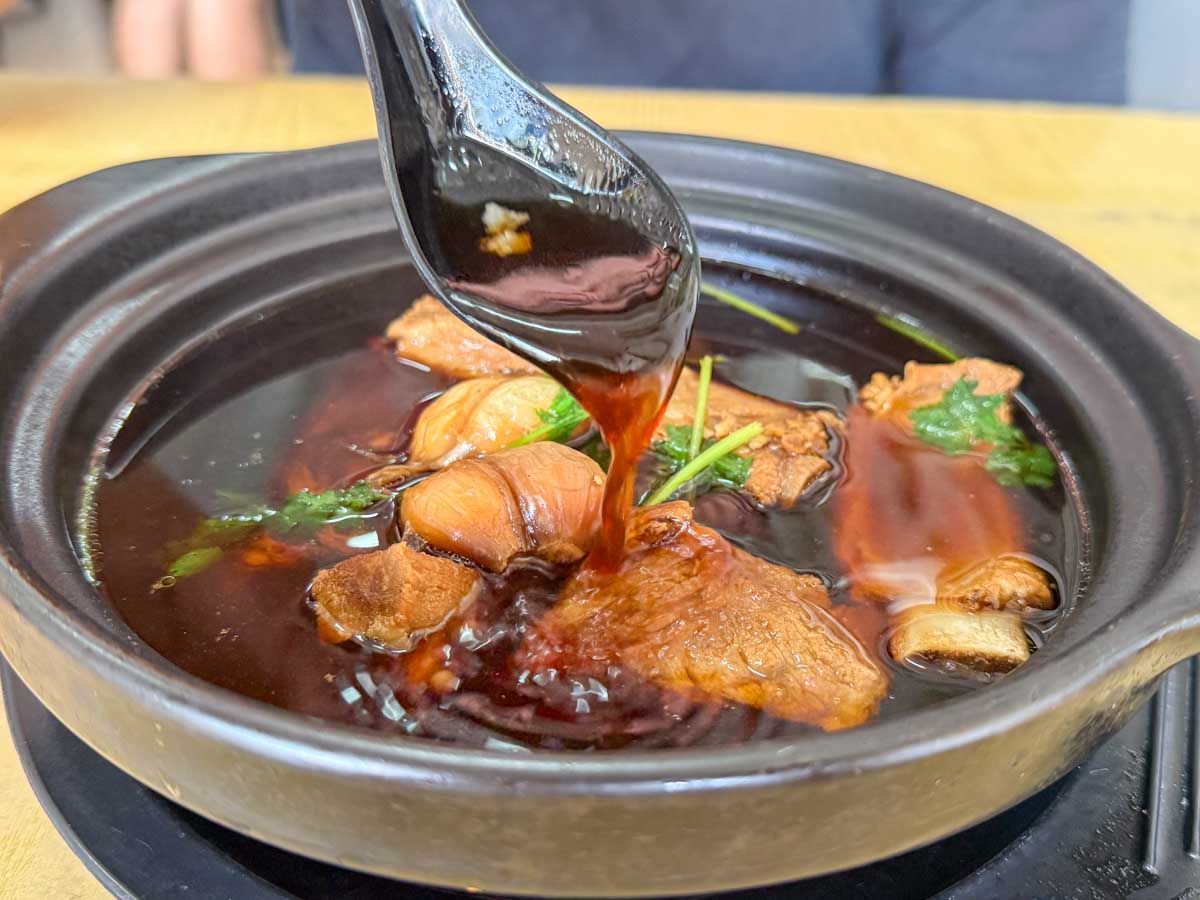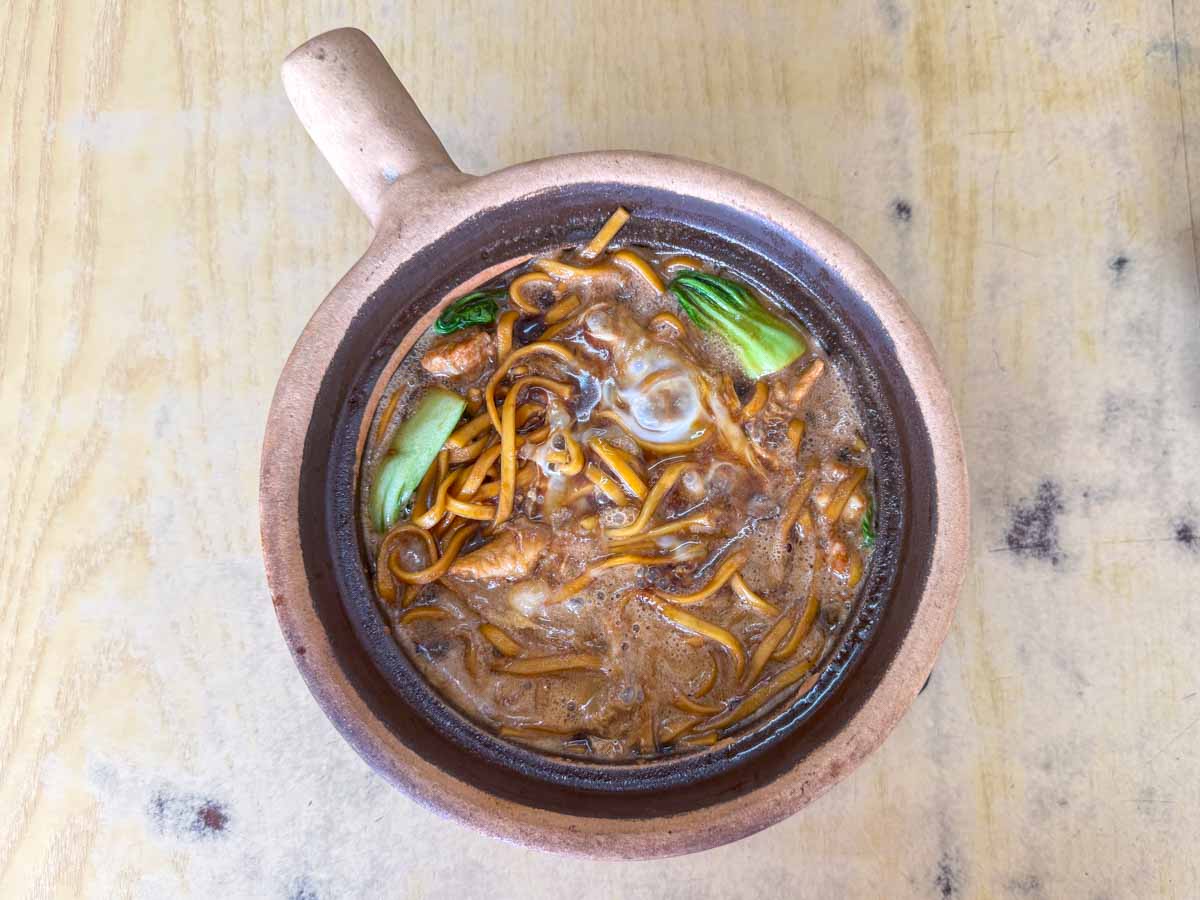‘Tis the season of newly minted Michelin awardees — and I bet the question on everyone’s minds is: deserving or not? It sure crosses mine all the time, and I’m lucky enough to have a job that lets me test it out. My conquest? None other than Sin Heng Claypot Bak Koot Teh, which clinched a Bib Gourmand in its very first year on the guide.
How fitting that it would mark my first-ever bak kut teh review too.
I’d heard plenty about Sin Heng Claypot Bak Koot Teh even before its grand entrance into the Michelin Guide. Mainly from my friend and his family, who’d rave about their bak kut teh so much you’d think it already had a star. Needless to say, I had him along with my lofty expectations in tow.
This iconic establishment traces its roots back to the 1980s, when it began as 2 stalls run by a seamstress-turned-hawker sister duo. They soon joined forces with several other family members, bringing their signature dish (and later zi char offerings) to the heart of Joo Chiat, where it’s remained since.

It’s like it hadn’t aged a day, either. There’s something about stepping into a no-frills space like theirs: weathered tables and chairs, a smattering of menu items plastered across the walls, clicky fans for ventilation and an open kitchen humming at the back. Nothing says “our only business is good food” quite like that — and it’s oddly charming.
What I tried at Sin Heng Claypot Bak Koot Teh

It felt almost mandatory to start with the Bak Koot Teh (S$10/S$15/S$25/S$38), so a S$15 portion to share was what I headed straight for. If you’re wondering how it differs from the Special Bak Koot Teh (S$10/S$17/S$27/S$40), I learnt that the latter includes a heavier dose of herbs, while the former is the eatery’s signature peppery-leaning brew.
You could call this the pioneer of its kind. Sin Heng Claypot Bak Koot Teh’s namesake was born when the towkays decided to serve the soup in claypots — both to keep it warm till the very last drop and to stand out from other joints. And there mine arrived, bubbling away in all its glory.

My first sip of broth was quite the head-scratcher. It was clear and light bodied, toeing the line between herbal and peppery without leaning strongly into either. As a fervent member of Team Peppery, I’ll admit it wasn’t entirely up my alley at first. But good things take time, as it gradually took on a richer profile as the pork ribs steeped, their meaty essence coaxing out a more robust, soulful finish.
Patience really is a virtue. Thank goodness each table has a handy pepper shaker too, as I got all the oomph I needed.

Speaking of the ribs, the generous portion of 5 sure was solid bang for buck. While not indulgently fall-off-the-bone tender as I’d hoped, each hunk yielded with a satisfying bite and carried the soup’s mellow savouriness. And hey, no complaints; not with the body it lent the broth.

I couldn’t pass up pairing my soup with a side of Yam Rice (S$1.20) and You Tiao (S$2.50).
The rice was fluffy and fragrant, its grains studded with soft yam chunks and laced with a subtle earthiness. It was comforting on top of comforting when eaten with the soup, though I’d say in hindsight that plain White Rice (S$1) might’ve offered a better contrast.
The you tiao, on the other hand, proved a non-negotiable as always. These golden, doughy fritters soaked up the broth like sponges, releasing it in warm, flavourful bursts as I reached for bite after bite.
We tried Singapore’s best-rated Bak Kut Teh

The next dish on our roster was the Claypot Noodles (S$6). Served in a well-worn claypot with a searing-hot handle (I found out the hard way), the noodles arrived in a furious simmer, cloaked in steam and that irresistible dark sauce gleam.
This was a steal and a half — I could hardly wrap my head around how the massive portion I was dealt set me back just S$6. I’d say it could easily feed 2 small eaters or 1 ravenous soul, perhaps even a whole family if you’re just tacking on a pot to pair with your bak kut teh.

Colour me surprised, as I didn’t expect to be hit by such a rich wok hei! It’s sadly rare to find that je ne sais quoi in even wok-fried dishes these days, so you can imagine my delight when these sauce-slicked strands of springy egg noodles came properly kissed with that smoky depth.
Flavour-wise, this dish reminded me of tai lok mee which, full disclosure, I’m not usually a fan of. This, though, had great dimension. It was savoury and well-balanced, with a creamy finish from the cracked egg and little bursts of umami from garlic and lard bits scattered throughout.

Within, I unearthed the usual suspects. The prawns, albeit small, were sweet enough that I savoured every piece, while the lean pork slices added a meaty heft and the greens lent a fresh, satisfying crunch that cut through the richness.
Final thoughts

So… is it worth the Michelin Bib? My short answer would be yes, but it’s neither a hesitant nor a resounding one.
My meal at Sin Heng Claypot Bak Koot Teh was undoubtedly satisfying, with the Claypot Noodles stealing the show for me with its wok hei, well-balanced flavours and generous portion.
On the other hand, while their signature claypot Bak Koot Teh was a slow grower on my pepper-loving heart, I wouldn’t quite place it among the most memorable bowls I’ve had. That said, I still think there’s plenty to laud about it: its soulful, herbal-leaning broth, a generous portion of meaty ribs and the warmth of a recipe steeped in years of tradition.
Is it one of those shiver-inducing, can’t-stop-thinking-about-it bowls? Not for me, at least. But is it reliable and worth trying at least once? I’d absolutely say so, especially for tourists looking for a taste of Singaporean bak kut teh, or locals craving a hearty, fuss-free fix.
Expected damage: S$6 – S$15 per pax
18 best bak kut teh spots in Singapore to warm up your soul [Oct 2024 update]
The post Sin Heng Claypot Bak Koot Teh: New Michelin Bib awardee with soulful broth, hearty ribs & old-school charm appeared first on SETHLUI.com.

